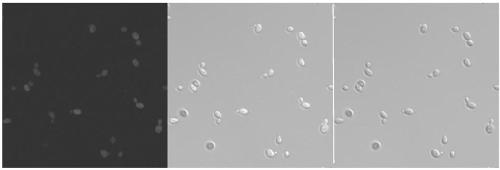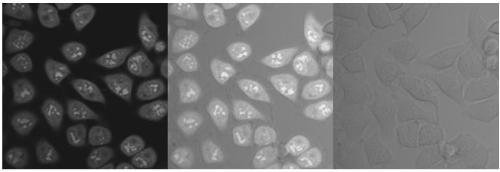Green fluorescent protein-based nanoparticle, preparation method and application thereof in cell imaging and cell nucleus nucleolar staining
A green fluorescent protein and nanoparticle technology, applied in the field of fluorescent protein-based nanomaterials, can solve complex, expensive, and not commercially available problems, and achieve good biocompatibility, no-cleaning imaging, and cost-effective effects
- Summary
- Abstract
- Description
- Claims
- Application Information
AI Technical Summary
Problems solved by technology
Method used
Image
Examples
Embodiment 1
[0016] In 0.8mL deionized water, add 0.1mL of Thioflavin-T aqueous solution with a concentration of 1mol / L as building molecules, add 0.1mL of Bovine Serum Albumin aqueous solution with a concentration of 1mol / L, and the dosage of Thioflavin-T and Bovine Serum Albumin in moles The ratio is 1:1. Then the solution was heated at a temperature of 100° C. for 10 minutes, and finally the solution was cooled to room temperature to obtain a green fluorescent protein-based nanoparticle solution. The concentration of the fluorescent protein-based nanoparticle was 6.4 mg / mL.
Embodiment 2
[0018] Saccharomyces cerevisiae cells use YPD (Yeast Extract Peptone Glucose Medium) as the culture medium, and incubate with shaking at 30°C until the OD600 reaches 1.0; take 1 mL of cell culture fluid and centrifuge to collect Saccharomyces cerevisiae cells, and wash the resulting cell strain with fresh YPD three times, then Resuspend the cells in 100 μL of YPD medium containing 0.1 mg / mL green fluorescent protein-based nanoparticles obtained in Example 1, and then put them back into a constant temperature shaker at 30°C and incubate for 6 hours; then take 1 mL of cell culture medium and centrifuge Collect the Saccharomyces cerevisiae cells, and resuspend the resulting cell strains in PBS buffer (pH 7.4) for 3 to 5 times to wash away the medium and fluorescent nanoparticles in vitro as much as possible to avoid background interference during confocal imaging; finally, 2μL The resuspension was dropped on a glass slide, and the cell imaging study was performed using a ZEISS LSM7...
Embodiment 3
[0020] Inoculate HeLa cells on a cover glass, culture in Dulbecco's modified Eagle medium (DMEM), change the culture medium once every 3 days, and control the incubator environment at 37°C and 5% CO 2 . The steps for staining nucleoli with fluorescent protein-based nanoparticles are as follows. Inoculate the above-mentioned cultured Hela cells in a cell containing 1 mg mL -1 T-FPNs were cultured on DMEM coverslips for 1 hour. After that, use a new cover glass to gently cover the cell-grown cover glass into the imaging chamber, wash twice with Hank's balanced salt solution (HBSS) and keep it in HBSS. Finally, imaging was performed using a ZEISS LSM700 confocal microscope equipped with a 100x oil objective lens (NA1.4) controlled by Zen software, 488nm and 555 lasers. Used to observe the effect of nucleolar staining.
PUM
| Property | Measurement | Unit |
|---|---|---|
| concentration | aaaaa | aaaaa |
Abstract
Description
Claims
Application Information
 Login to View More
Login to View More - R&D
- Intellectual Property
- Life Sciences
- Materials
- Tech Scout
- Unparalleled Data Quality
- Higher Quality Content
- 60% Fewer Hallucinations
Browse by: Latest US Patents, China's latest patents, Technical Efficacy Thesaurus, Application Domain, Technology Topic, Popular Technical Reports.
© 2025 PatSnap. All rights reserved.Legal|Privacy policy|Modern Slavery Act Transparency Statement|Sitemap|About US| Contact US: help@patsnap.com



